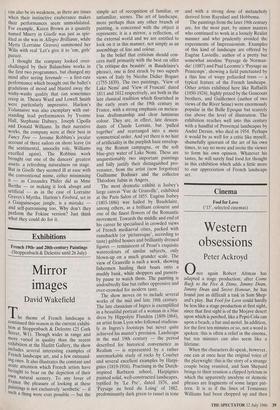Exhibitions
French 19th- and 20th-century Paintings (Stoppenbach & Delestre until 26 July)
Mirror images
David Wakefield
The theme of French landscape is continued this season in the current exhibi- tion at Stoppenbach & Delestre (25 Cork Street, W1). Though wider in range and more varied in quality than the recent exhibition at the Hazlitt Gallery, the show includes several interesting examples of F. rench landscape art, and a few outstand- ing ones. It also illustrates the constant and acute attention which French artists have brought to bear on the depiction of their Own natural scenery. To any lover of France the pleasure of looking at these paintings is not exclusively 'aesthetic' — if such a thing were ever possible — but the
simple act of recognition of familiar, or unfamiliar, scenes. The art of landscape, more perhaps than any other branch of painting, is concerned with the object it represents; it is a mirror, a reflection, of the external world and we are entitled to look on it in this manner, not simply as an assemblage of line and colour.
In the belief that criticism should con- cern itself primarily with the best on offer (la critique des beautes' in Baudelaire's phrase), one is first struck by two superb views of Italy by Nicolas Didier Boguet (1755-1839). The two paintings, 'View of Lake Nemi' and 'View of Frascati' dated 1811 and 1812 respectively, are both in the late classical tradition which flourished in the early years of the 19th century in France, with a strong emphasis on meticu- lous draftsmanship and clear luminous colour. They are, in effect, late descen- dants of Claude Lorrain, but 'pulled together' and rearranged into a more symmetrical order. And yet there is no hint of artificiality in the purplish haze envelop- ing the Roman campagna, or the soft blue-grey water of Lake Nemi. These are unquestionably two important paintings and fully justify their distinguished pro- venance, from the artist (now forgotten) Guillaume Bodinier and the collector Theodore Jubin in Angers.
The most dramatic exhibit is Isabey's large canvas 'Niue de Granville', exhibited at the Paris Salon of 1855. Eugene Isabey (1803-1886) was hailed by Baudelaire, among others, as a brilliant colourist and one of the finest flowers of the Romantic movement. Towards the middle and end of his career he specialised in crowded views of French mediaeval cities, packed with ramshackle (or 'picturesque', according to taste) gabled houses and brilliantly dressed figures — reminiscent of Prout's exquisite watercolours of similar subjects, only blown-up on a much grander scale. The view of Granville is such a work, showing fishermen hauling their boats onto a muddy bank, while shoppers and passers- by pause to watch them. The painting is undoubtedly fine but rather oppressive and over-crowded for modern taste.
The show moves on to include several works of the mid and late 19th century. The late classicism of Ingres is exemplified in a beautiful portrait of a woman in a blue dress by Hippolyte Flandrin (1809-1864), an artist from Lyon who followed studious- ly in Ingres's footsteps but never quite achieved his master's precision. Landscape in the mid 19th century — the period described for historical convenience as Realism — is represented by a rather unremarkable study of rocks by Courbet and several excellent examples by Harpi- gnies (1819-1916). Practising in the Dutch- inspired Barbizon school, Harpignies painted solid, well-constructed landscapes, typified by `Le Pre', dated 1876, and `Paysage au bord du Loing' of 1882, predominantly dark green to russet in tone
and with a strong dose of melancholy derived from Ruysdael and Hobbema.
The paintings from the later 19th century are, for the most part, by minor masters who continued to work in a loosely Realist manner and who prudently avoided the experiments of Impressionism. Examples of this kind of landscape are offered by Eugene Lavieille, author of a pretty but somewhat anodine 'Paysage de Norman- die' (1887) and Paul Lecomte's 'Paysage au Printemps', showing a field punctuated by a thin line of wispy pollarded trees — a typical feature of the French landscape. Other artists exhibited here like Raffaelli (1850-1924), highly prized by the Goncourt brothers, and Guillermot (author of two views of the River Seine) were enormously popular in the Belle Epoque but scarcely rise above the level of illustration. The exhibition reaches well into this century with a handful of Provençal landscapes by Andre Derain, who died in 1954. Perhaps it would be as well for a critic like myself, shamefully ignorant of the art of his own times, to say no more and invite the viewer to form his own opinion. Whatever his tastes, he will surely find food for thought in this exhibition which adds a little more to our appreciation of French landscape art.


















































 Previous page
Previous page